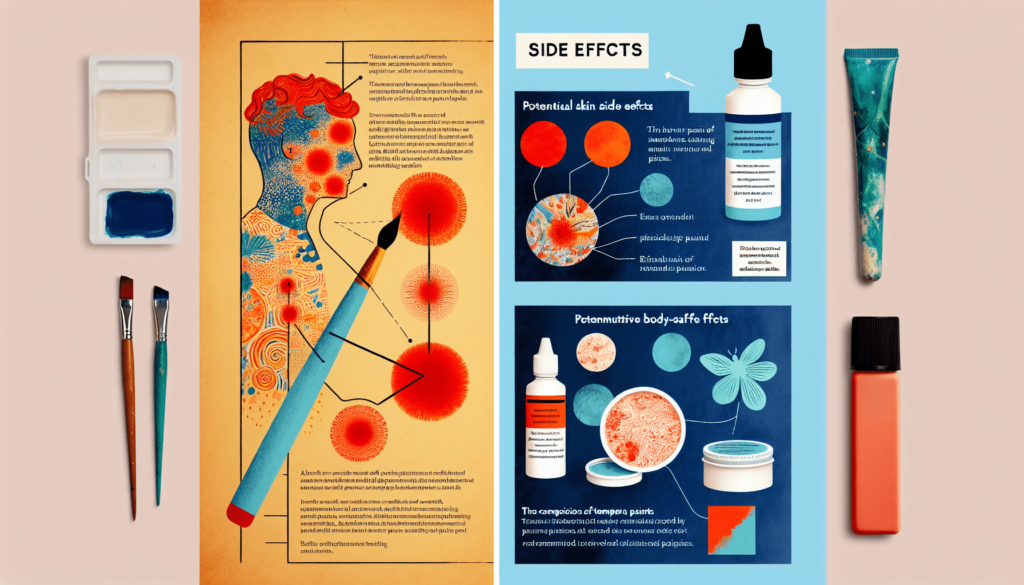Tempera paint, a versatile and widely-used medium in the art world, has long been cherished for its vibrant hues and smooth texture. Artists have explored its endless possibilities, harnessing its ability to create stunning works of art on various surfaces. However, a burning question remains: can tempera paint be safely used on the delicate canvas of human skin? In this article, we will carefully analyze the chemical composition of tempera paint, consider its potential effects on the skin, and provide valuable insights into the safe usage of this artistic tool for body art purposes. So, if you’re curious about the compatibility of tempera paint with the human epidermis, read on to gain a comprehensive understanding of this artistic dilemma.
What is tempera paint?
Definition
Tempera paint is a type of paint that is commonly used in arts and crafts projects. It is made by combining pigments with an adhesive or binder, usually a water-based medium. This type of paint dries to a matte finish and is known for its vibrant colors and smooth texture.
Ingredients
Tempera paint is typically made up of a few key ingredients. The pigments in tempera paint are usually derived from natural or synthetic sources, providing a wide range of colors. The binder or adhesive used in tempera paint is often a combination of water, egg yolk, gum arabic, or other similar substances. Additional ingredients such as preservatives or stabilizers may also be included to enhance the longevity and shelf life of the paint.
Safety concerns with tempera paint
Toxicity
Tempera paint is generally considered to be non-toxic, making it safe for use by children and adults. However, some pigments used in certain brands of tempera paint may contain small amounts of toxic substances. It is important to read the labels and safety information provided by the paint manufacturer to ensure that the paint is indeed non-toxic and safe for use on the skin.
Allergic reactions
While tempera paint is generally safe for most individuals, some people may be allergic to certain ingredients found in the paint. Common symptoms of an allergic reaction to tempera paint include itching, redness, and skin rashes. It is always recommended to perform a patch test on a small area of skin before applying tempera paint to a larger area.
Skin irritations
In some cases, tempera paint may cause skin irritations, especially if the skin is already sensitive or compromised. It is important to keep the skin clean and well-moisturized before and after using tempera paint to minimize the risk of skin irritations. If any discomfort or redness occurs, the paint should be promptly removed and further application should be avoided.

The use of tempera paint on skin
Face painting
Tempera paint can be used for face painting to create fun and colorful designs. Face painting is a popular activity at parties, festivals, and other events where individuals can transform themselves into their favorite characters or creatures. With its wide range of colors, tempera paint allows for endless possibilities and creativity in face painting.
Body painting
Body painting involves using tempera paint to cover larger areas of the body, creating unique and intricate designs. It is often seen in artistic performances, photo shoots, or cultural celebrations. Body painting can be a temporary form of self-expression or a way to explore different art forms.
Temporary tattoos
Using tempera paint to create temporary tattoos is another way to utilize its vibrant colors and versatility. Temporary tattoos are often used as a form of body decoration or as a way to test out a design before committing to a permanent tattoo. With proper application and removal techniques, tempera paint can create stunning temporary tattoos.
Precautions when using tempera paint on skin
Patch test
Before applying tempera paint to a larger area of skin, it is important to perform a patch test. This involves applying a small amount of paint to a small, inconspicuous area of skin and monitoring for any adverse reactions. If any irritation or allergic reactions occur, the paint should not be used on the skin.
Non-toxic alternatives
If concerns about toxicity arise or if someone has sensitive skin, it may be advisable to consider using non-toxic alternatives to tempera paint. There are various water-based face paints and body markers available on the market that are specifically formulated for safe use on the skin. These alternatives often provide similar vibrant colors and can still be used for face painting, body painting, and temporary tattoos.
Proper application
To minimize any potential risks or skin irritations, proper application techniques should be followed when using tempera paint on the skin. It is important to avoid applying the paint too thickly, as this can lead to cracking or flaking. Additionally, removing the paint gently and thoroughly after use can help prevent any residual pigments from causing skin reactions or staining.

Removal of tempera paint from skin
Soap and water
The most common and readily available method for removing tempera paint from the skin is using soap and water. When washing off the paint, it is important to use mild soap and warm water, gently massaging the skin to loosen the paint. Rinse thoroughly and pat dry to ensure all traces of paint are removed.
Makeup remover
For more stubborn or heavily pigmented areas, a gentle makeup remover can be used to effectively remove tempera paint from the skin. Makeup removers specifically designed for use on the face and sensitive skin are recommended to avoid further skin irritations or reactions.
Baby oil
In some cases, baby oil can be used as an alternative method for removing tempera paint from the skin. Apply a small amount of baby oil to the painted area, gently massaging it into the skin. Then, using a clean cloth or cotton pad, wipe away the paint. Afterward, cleanse the skin with soap and water to remove any residual oil.
Benefits of using tempera paint on skin
Non-permanent
One of the significant advantages of using tempera paint on the skin is its temporary nature. Unlike permanent tattoos or other forms of body art, tempera paint can easily be washed off, allowing individuals to experiment with different designs and colors without the long-term commitment.
Wide range of colors
Tempera paint offers a wide range of colors to choose from, providing endless possibilities for creative expression. From bold primary colors to soft pastels, tempera paint can be mixed and blended to achieve desired shades and hues.
Allows creativity
Using tempera paint on the skin allows individuals to unleash their creativity and create unique designs. Whether it’s for a special occasion or simply for personal enjoyment, the use of tempera paint can be a fun and artistic way to express oneself.
Risks of using tempera paint on skin
Potential skin reactions
Although tempera paint is generally considered safe, there is a risk of potential skin reactions, especially for individuals with sensitive skin or allergies. It is essential to be aware of any discomfort or irritation that may arise and to discontinue use if any adverse reactions occur.
Staining
While tempera paint is water-soluble and easily removable from the skin, certain pigments may leave behind temporary stains. Darker or more intense colors may have a higher likelihood of staining, so it is important to choose colors carefully, especially when applying tempera paint to visible areas of the skin.
Difficulty in removal
In some cases, tempera paint may be more difficult to remove from certain areas of the skin, such as creases or textured surfaces. This can lead to frustration and potential skin irritation if excessive force or harsh methods are used to remove the paint. Proper cleansing techniques and patience are necessary to ensure gentle and complete removal.
Using tempera paint for special occasions
Halloween
Halloween is a popular occasion for using tempera paint on the skin. From creating spooky face designs to transforming into favorite Halloween characters, tempera paint allows for imaginative and unique looks. However, it is crucial to prioritize safety and follow proper guidelines when applying and removing the paint to avoid any potential negative effects on the skin.
Costume parties
Costume parties are another opportunity to incorporate tempera paint into one’s attire. Whether it’s to enhance a costume or create an entirely new character, tempera paint can add the finishing touch to a creative ensemble. As always, precautions should be taken to ensure the safety and comfort of the skin during and after the event.
Theatrical performances
Theatrical performances often require elaborate makeup and body art, and tempera paint can be a useful tool for achieving desired effects. From enhancing facial expressions to creating fantastical creatures, tempera paint can be a valuable asset for bringing characters to life on the stage. Careful consideration must be given to the potential sensitivities of performers and appropriate removal methods after each performance.
Appropriate age groups for using tempera paint on skin
Children
Tempera paint is generally safe for use on children’s skin, especially if it is labeled as non-toxic and specifically formulated for use on the skin. However, adult supervision is recommended to ensure proper application, avoidance of sensitive areas such as the eyes and mouth, and thorough removal after use.
Teens
Teenagers can safely use tempera paint on their skin, provided they follow proper precautions and guidelines. They may enjoy experimenting with various designs and colors for parties, school events, or simply for self-expression. However, it is important for teens to be aware of any potential skin allergies or sensitivities they may have and to discontinue use if any adverse reactions occur.
Adults
Adults can also utilize tempera paint on their skin for various occasions, such as costume parties, festivals, or artistic endeavors. With their maturity and understanding of potential risks, adults can ensure they make informed decisions about using tempera paint and take appropriate measures to protect their skin.
Alternatives to using tempera paint on skin
Face and body markers
Face and body markers are a popular alternative to tempera paint for those who prefer a convenient and mess-free option. These markers are specifically designed for use on the skin, often with non-toxic formulations. Face and body markers provide quick and precise application, making them ideal for intricate designs or detailed work.
Water-based face paints
Water-based face paints are another alternative to tempera paint. These products are specifically formulated to be safe for use on the skin and are available in a variety of colors and finishes. Water-based face paints can be easily applied, blended, and removed with soap and water, making them a practical choice for temporary body art.
Makeup
Traditional cosmetics and makeup can also be used as an alternative to tempera paint. Many formulations of makeup, such as cream-based or water-based products, can be safely applied to the skin and provide a wide range of colors and textures. However, it is important to choose makeup products that are labeled as safe for use on the skin and to follow proper application and removal techniques.
In conclusion, tempera paint can be used on the skin for various purposes such as face painting, body painting, and temporary tattoos. While generally safe, it is essential to consider potential risks and take appropriate precautions, including performing patch tests, using non-toxic alternatives, and following proper application and removal techniques. Tempera paint offers a wide range of colors and allows for creativity, making it a popular choice for special occasions such as Halloween, costume parties, and theatrical performances. However, individuals should be mindful of appropriate age groups for using tempera paint on the skin and consider alternatives like face and body markers, water-based face paints, or makeup. By understanding the benefits, risks, and alternatives, individuals can safely and enjoyably incorporate tempera paint into their artistic endeavors.



